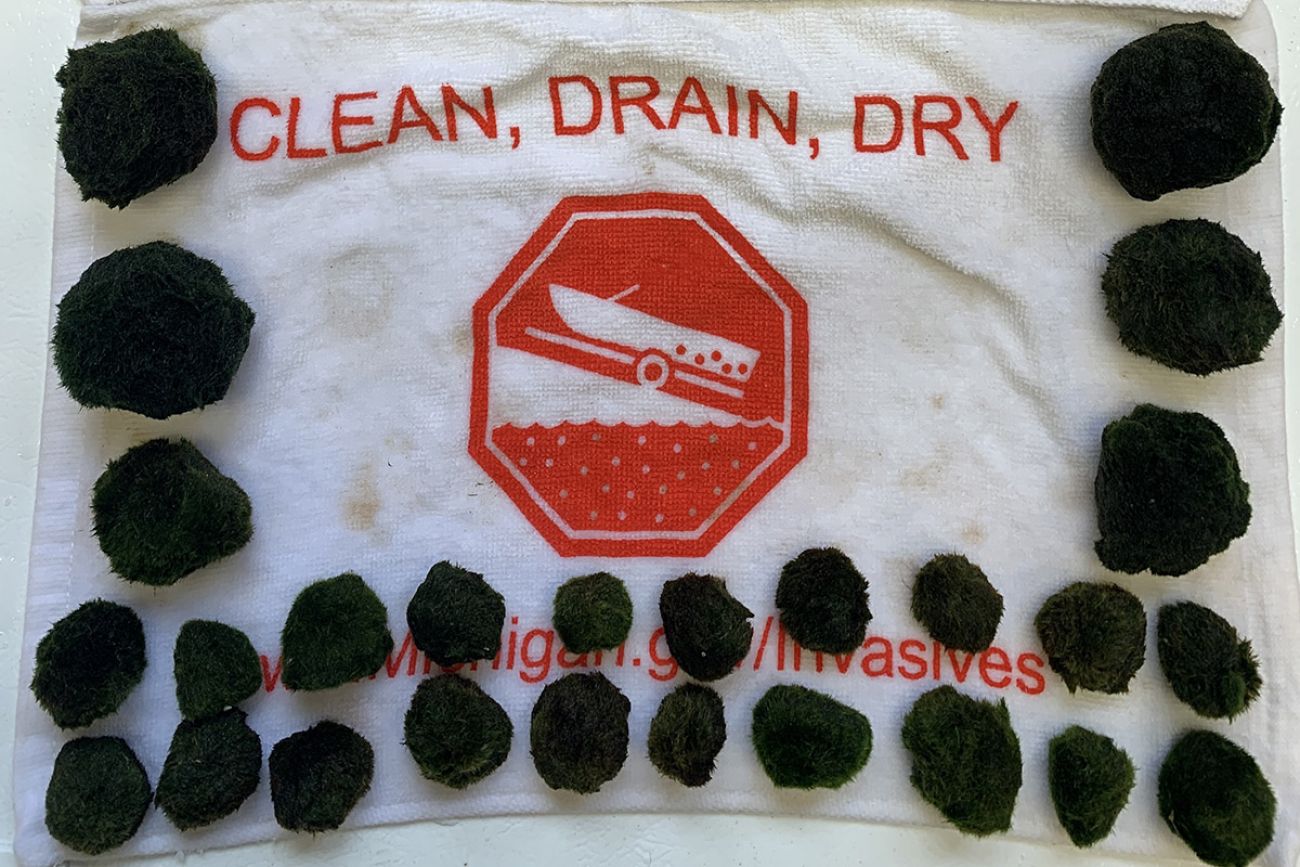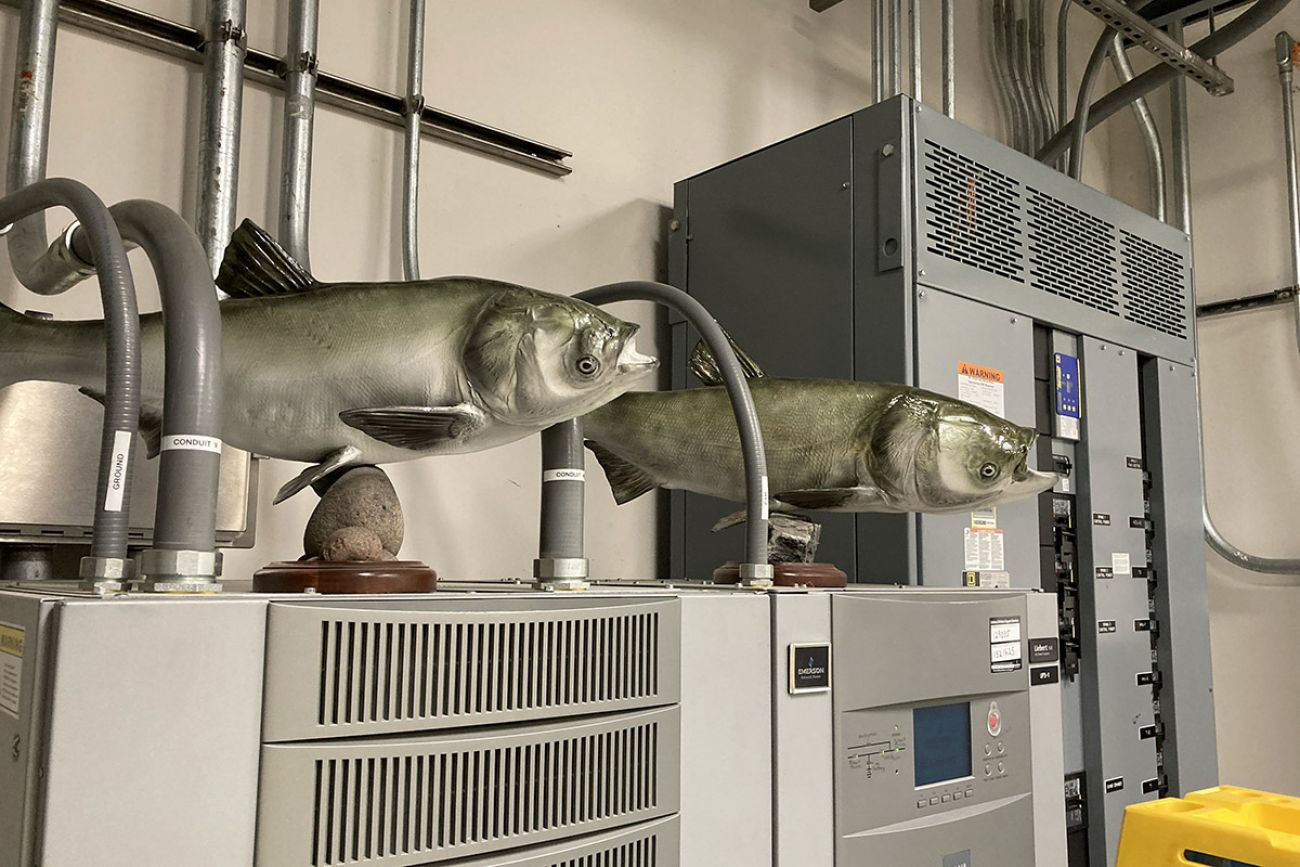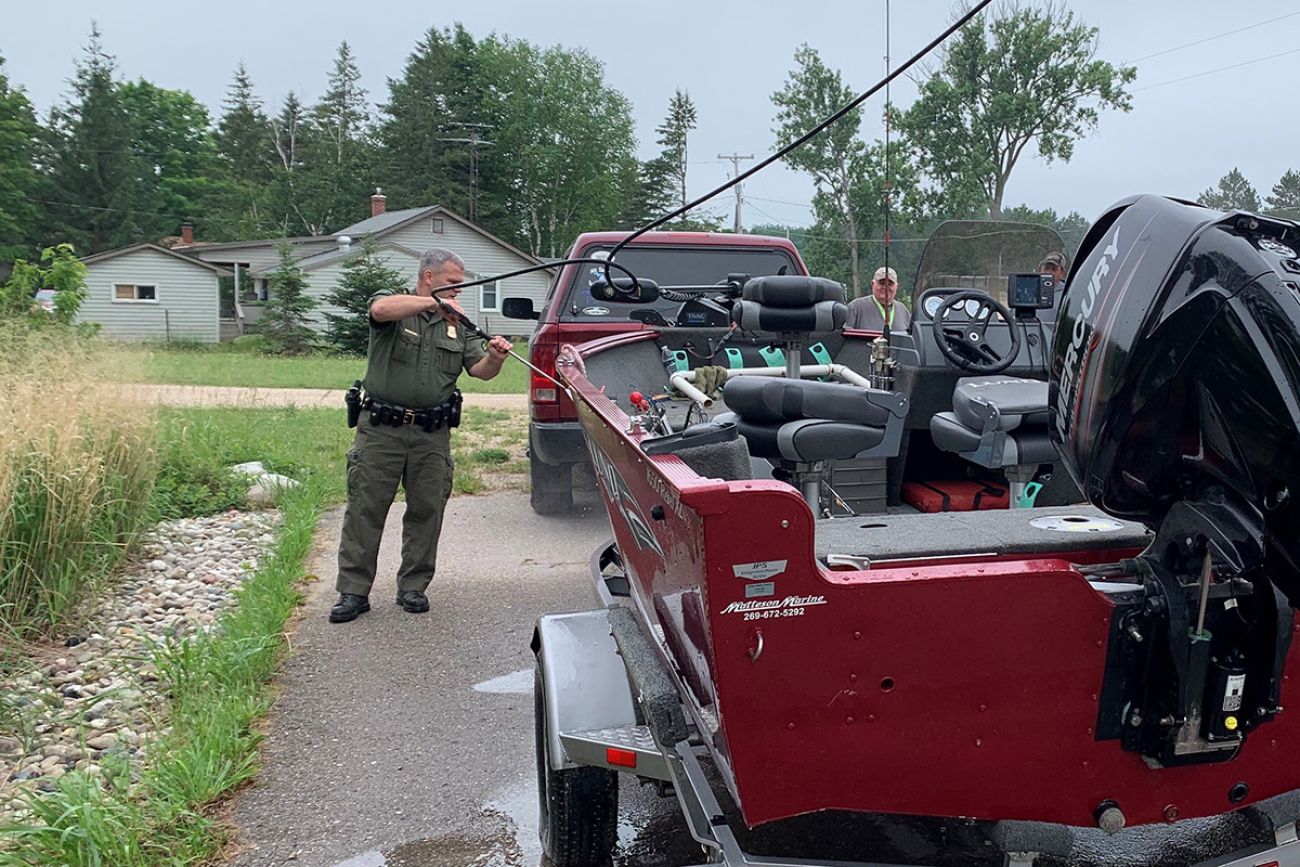
By Kelly House, Bridge Michigan
The Great Lakes News Collaborative includes Bridge Michigan; Circle of Blue; Great Lakes Now at Detroit Public Television; and Michigan Radio, Michigan’s NPR News Leader; who work together to bring audiences news and information about the impact of climate change, pollution, and aging infrastructure on the Great Lakes and drinking water. This independent journalism is supported by the Charles Stewart Mott Foundation. Find all the work HERE.
It was a year ago this month when Michigan fish and wildlife regulators caught wind that aquarium moss balls sold in a Washington state pet shop were infested with zebra mussels, an invasive species that has decimated Great Lakes ecosystems.
Within a day, Corporal Nick Torsky and his fellow Michigan Department of Natural Resources Great Lakes law enforcement officers were crisscrossing the state to find and destroy any shipments that may have reached Michigan.
Many Michigan waterways are already heavily-infested with the mussels, which are native to eastern Europe and western Asia. Torsky and his colleagues were hell bent on preventing further spread.

Michigan DNR officers last year fanned out across the state to confiscate moss balls (spheres of algae) from aquarium retail stores after learning the balls could be infested with invasive zebra mussels. (Photo courtesy of Nick Torsky)
“We do have a few inland water bodies that are still (invasive mussel) free,” Torsky said. “And we’d certainly like to keep them that way.”
Operation Moss Ball hints at an evolution in recent years: Past catastrophes, like the mussel invasion that has transformed the Great Lakes since it began in the 1980s, have prompted state and federal lawmakers to tighten regulations and loosen purse strings to better prevent new invasions, rather than simply responding after-the-fact.
Put another way, “Once you get punched in the face a few times, you start to learn how to fight back,” said Joel Brammeier, president and CEO of the nonprofit water advocacy group Alliance for the Great Lakes.
A big milestone in that process came in January: The U.S. Army Corps announced $226 million to complete design on the Brandon Road Interbasin Project project, an $858 million effort to keep carp downstream of Joliet, Illinois in the Des Plaines River — and out of the Great Lakes.
But Great Lakes advocates say more work is needed to close off other pathways for potential invasion, from Great Lakes freighters to recreational boats and online pet shops.
A multi-billion dollar threat
The silver and bighead carp found throughout the Mississippi River Basin are capable of widespread destruction. They gobble up plankton that other fish rely upon for food, and can destroy habitat and water quality. Research has shown the carp would find a hospitable new home in the Great Lakes, potentially doing millions of dollars worth of damage every year.
One study found an invasive carp invasion could cause “moderate to high” damage to the commercial and recreational fishing, boating, wildlife viewing, beaches and lakefront economies that are worth an estimated $8.5 billion annually to the Canadian economy. When both the U.S. and Canada are included, Great Lakes commercial, Tribal and recreational fishing is worth $7 billion.
The Great Lakes states and federal government already expend considerable money and effort to prevent an invasion. It costs about $13 million annually to operate electric barriers on the Chicago Sanitary and Ship Canal near the Chicago suburb of Lockport, which keep carp from swimming up the canal, into the Chicago River and on to Lake Michigan.

Two taxidermied carp gussy up an otherwise-undecorated building housing electrical equipment that powers electrical barriers meant to keep invasive carp from migrating up the Chicago Sanitary and Ship Canal. (Bridge photo by Kelly House)
The current system has limitations. For example, its electric barriers sag when barges pass through, creating brief windows during which a small fish could potentially pass through unscathed.
The Corps is working to close those loopholes by building a new barrier in Lockport capable of delivering a stronger jolt. The Brandon Road Interbasin Project — on the Des Plaines River about 12 miles south of the existing Lockport barriers — will add yet another layer of protection.
An invasive carp traveling upstream toward the lock and dam would face a gauntlet that begins with commercial fishing downstream of the Joliet structure. If a fish evades the nets, it will swim into a column of bubbles meant to prevent carp and their eggs and larvae from hitching a ride in the crevices around barges.
Next, another bubble screen and noise broadcast into the water, prompting fish to escape the annoyance by swimming away from the lock, instead congregating below the impassable dam where fishermen await.
Fish undeterred by the bubbles and noise will encounter electric barriers and another field of speakers upstream.
“We are confident that the combination of structural and nonstructural measures working together will be effective in keeping invasive carp out of the lakes,” said Andrew Leichty, project manager for the U.S. Army Corps of Engineers, Rock Island District.
Corps officials say once completed, the chance of a carp swimming upstream into the Great Lakes is virtually impossible. Under current timelines, the barrier would be complete in 2030 at the earliest.
It will be an expensive undertaking, coming in at $858 million and six to eight years of construction time.
But Great Lakes advocates call that chump change compared to the possible cost of a carp invasion.
One 2005 study put the current cost of aquatic invasives in the Great Lakes region at $5.7 billion per year. Advocates note that number has undoubtedly grown in the years since, as new invaders have arrived.
“That’s just a peek into what this means for Michigan residents,” said Sarah LeSage, aquatic invasive species coordinator for the Michigan Department of Environment, Great Lakes and Energy (EGLE). “And you can’t go back.”
Zebra and quagga mussels are a good example. They forever changed the Great Lakes, elbowing out other species and fundamentally altering the lakes’ chemistry. They have played a role in everything from plummeting whitefish catches to rising avian botulism that has killed waterfowl species such as loons and mergansers, cormorants and gulls.
Water providers, power plant operators and others who pull water from the lakes each spend an average of $100,000 annually to clear the mollusks from their intake pipes, said Rochelle Sturtevant, program manager of the Great Lakes Aquatic Nonindigenous Species Information System, a federally-funded invasive species tracking program.
Learning from those past experiences has changed Michigan’s strategy, LeSage said, prompting state officials to dramatically increase efforts to contain invasives before they become established.
Before 2010, LeSage said, Michigan had just $24,000 in dedicated funding for such efforts. Today, the figure is about $9 million annually, including federal dollars from the 2010 Great Lakes Restoration Initiative and a $5 million state appropriation legislators created in 2014.
Those funds have been “a game changer,” LeSage said, allowing the state to detect new invasions earlier, and respond more forcefully.
Efforts take the form of law enforcement actions, like seizures of red swamp crayfish — which prey on native fish and plants and can spread disease — at the Canadian border, outreach efforts such as the annual Great Lakes Aquatic Invasive Species Landing Blitz that encourages recreational boaters to “clean, drain, dry” their boats, which reduces the volume of invasive hitchhikers, surveillance of the online live species trade, and grant programs that support local invasive species management efforts.

Michigan’s dedicated funding to address invasive species issues has increased dramatically since 2010, when it stood at just $24,000. Now, it’s about $9 million. Annual boat wash demonstrations are among the state’s efforts to control the spread. (Photo courtesy of Nick Torsky)
Is it enough?
The Brandon Road Project in Joliet will close the biggest remaining entry point for invasive carp, said Brammeier, of Alliance for the Great Lakes. But too many doorways remain open for other species to make their way into the lakes and spread throughout them.
Brammeier puts the ballast water of Great Lakes trade vessels near the top of the list.
Ocean-going ships must replace their ballast water with seawater before entering the Great Lakes – a process that kills many non-native organisms. But ships traveling exclusively in the Great Lakes, known as lakers, are not required to treat their ballast water.
Great Lakes advocacy groups have pushed for change. Canada is requiring freshwater vessels to have ballast water treatment installed by 2030. Brammeier wants to see the same mandate from the U.S.
But proposed federal standards under the Vessel Incidental Discharge Act, announced during the Trump administration, do not include treatment requirements for lakers. And they strip away some existing requirements that apply to lakers.
Gov. Gretchen Whitmer has formally objected to the proposed standards. State regulators argue the EPA analysis that led to the proposed rule change was lacking, and that the rules themselves are too weak.
Shipping industry groups argue the proposed rules are fair. Requiring ballast water treatment would be pointless, said James Weakley, president of the Lake Carriers’ Association, because current technologies are either ineffective in the Great Lakes, or incompatible with the existing fleet (for example, U.S. boats lack protective coating to withstand harsh chlorine disinfectants).
“There is not a technology in existence that will allow us to treat our ballast water,” Weakley said.
EPA spokesperson Taylor Gillespie told Bridge in an email that the agency is reviewing public comment and plans to move forward with the rule. Gillespie noted the agency is supporting research into technologies that could prevent the spread of invasives from lakers’ ballast water.
“EPA expects the result of this effort will support enhanced ballast water regulations for vessels operating within the Great Lakes System,” Gillespie said.
Other proposed federal changes could help slow the spread, said Sturtevant. One example: proposed changes to the federal Lacey Act that would tighten restrictions on the types of species that can be imported into the country and authorize federal regulators to issue emergency bans on newly-identified problem species.
Torsky, the DNR officer, said he is focused on closing loopholes at the state level.
In recent years, the state has ramped up reporting requirements for the live animal trade. And new regulations approved last year will require anyone transporting dead invasive fish through the state to eviscerate them first.
“Just about the time you think you’ve figured it out,” Torsky said, “something else pops up for sale on eBay or Amazon.”
And regulators still struggle to raise awareness among the public about its role in stopping the spread. Many invasives migrate from lake to lake in the rudders of recreational fishing boats, or the mud stuck to hikers’ boots. And frequent detections of alligators and goldfish in the lakes are a dead giveaway that people are still dumping their aquariums in local waterways.
“This is a global problem, it’s a regional problem,” LeSage said. “But what I fear is sometimes lost is that the individual actions matter just as much for your local water bodies.”
Catch more news at Great Lakes Now:
Canada expands ballast water restrictions to reduce invasive species spread
Featured image: Electric barriers in the Chicago Sanitary and Ship Canal are currently the main line of defense keeping invasive carp from migrating upstream and into the Great Lakes. (Bridge photo by Kelly House)




